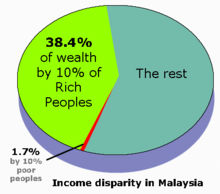Income disparity
2007 Schools Wikipedia Selection. Related subjects: Economics
Income disparity or wage gap is a term used to describe inequities in average pay or salary between socio-economic groups within society, or the inequities in pay between individuals who produce the same work. Income disparity generally occurs when certain groups within society suffer from social inequality within a society.
Common examples include:
- lower average income for females than males (see Gender gap below)
- Income discrepancy between minority racial or ethnic groups and the majority.
- The income gap between the wealthy and the poor.
Gender gap
In the context of economic inequality, gender gap generally refers to the systemic differences in the social and economic roles of men and women, or boys and girls. There is a debate to what extent this is the result of gender differences, lifestyle choices, or because of discrimination.
The widespread mechanization of industry has been accompanied by a shift in gender differentials in highly industrialized countries. However, this closing of the gender gap has not necessarily been followed in less industrialized countries, where women may earn less than two thirds that of men.
A United Nations report found that women working in manufacturing earned the following percentages in relation to men in 2003:.
- Botswana: 53%
- Columbia: 65%
- Paraguay: 53%
- Japan: 60%
- Singapore: 61%
- Sri Lanka: 81%
- Denmark: 87%
- France: 78%
- Germany: 74%
- Hungary: 74%
- Ireland: 69%
- Latvia: 82%
- Lithuania: 77%
- Malta: 92%
- Sweden: 91%
- Ukraine: 69%
- United Kingdom: 79%
- New Zealand: 80%
In 2004, women's wages in the USA were 76.5% of men's wages. This number compares the income off all men and women who work 35 hours or more each week. However, some studies, such as those done by the Independent Women's Forum, conclude that when taking into account variables when comparing male and female employment within the United States - type of job, hours worked in a week, tenure, benefits (for example maternity leave) - women make 98% of men's income. For further information, see Male-female income disparity in the USA .
According to the Centre for Economic Performance (CEP) at the London School of Economics, it would take 150 years for the income gap between the two genders to close up due to discrimination and ineffective government policies.
Income disparity in Malaysia
According to the UNDP 1997 Human Development Report, and the 2004 United Nations Human Development (UNHDP) report, Malaysia has the highest income disparity between the rich and poor in Southeast Asia, greater than that of Philippines, Thailand, Singapore, Vietnam and Indonesia. The UNHDP Report shows that the richest 10% in Malaysia control 38.4% of the economic income as compared to the poorest 10% who control only 1.7%. Kuala Lumpur as the capital of Malaysia has an increasing number of squatters, shanty towns and slums, and is also seeing an increase in criminal acts such as snatch theft, robberies, and rape.
